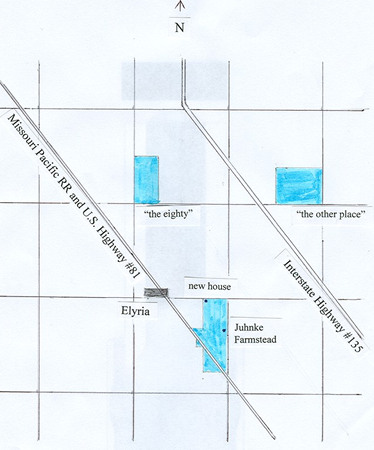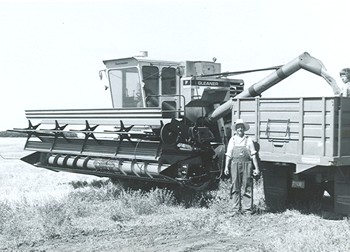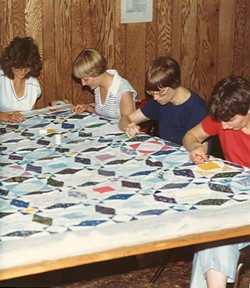|
Livestock on the Juhnke farm included twenty nine cattle, including
two milk cows. Thirty cattle had been sold in 1969. There were eight
chickens and two hogs. Four hogs had been sold that year. Bill and
Meta had paid only thirty-two dollars for commercial feed for the
livestock. They were raising their own feed. They were eating eggs,
meat, milk products and garden produce that they had grown on the
farm. Another measure of their self-sufficiency was that they had
paid only $270 for farm labor in 1969. It is possible that some of
that money went to their own children.
Juhnke farm income in 1969, in addition to sale of grains and alfalfa,
included $2,515 from government farm subsidies, and $500 for custom
combining. Total farm income was $6,820 more than total expenses.
This was clearly a viable farm operation, even if it was not going
to make Bill and Meta wealthy. There surely were fluctuations from
year to year in the 1970s and 1980s, depending upon the weather and
volatile grain prices. But this remained, as long as Bill's health
allowed, a diversified family farm, focused mainly on wheat production.
It represented a level of independence and self-sufficiency that were
becoming increasingly rare on the American agriculture scene.
If Bill and Meta Juhnke were distressed or depressed about the bleak
prospect of the small family farm in general, they did not talk or
write about it. To be sure, they complained about low wheat prices
and expensive equipment. But they loved their life on the farm and
they held onto it as long as their health allowed. When they reached
their sixty-fifth birthday they were eligible for Social Security
payments and, for Bill, teacher retirement payments. Not only did
Bill have a kind of mystical attachment to the land, he was also an
incurable progressive who looked forward with optimism to the future.
For him the cup was always half full, not half empty. Moreover, he
was always convinced that progress toward realizing the kingdom of
God on earth depended upon committed Christians who worked at the
local level-in primary family, church and community contexts. In 1973,
when challenged to write some lyrics for the centennial celebration
of the Swiss-Volhynian migration to America, Bill offered some lines
to counter the otherworldly emphasis of a proposed centennial hymn,
"To God be the Glory." Bill's lyrics pointed forward to a greater
future here "on earth." Jesus was to be seen "among us," rather than
just far away in heaven. Bill suggested the following verse.
"Our Fathers have left us some things to be done,
on Earth in our hearts are some victories not won.
Ah, purer and higher and greater will be,
the future among us as Jesus we see."
In May 1967 Bill Jr. graduated from Bethel College. In his class
was Carita Preheim, from Freeman, South Dakota. Carita had completed
the nursing program at Bethel Deaconness Hospital and had returned
to Bethel for a liberal arts degree. She was a gifted musician and
had been elected Bethel's homecoming queen. Bill and Carita were married
June 1 at Carita's home church, Salem Mennonite, near Freeman. In
the fall of 1968 they moved to Lawrence, Kansas, where Bill entered
an American history graduate program to prepare for a college teaching
career. To celebrate Bill and Carita's marriage, Jim and Anna composed
some verses:
"Football queen and opera star, Carita's quite a catch.
She can bake a coffee cake and she can sew a patch.
Dakota seems so far away, but though it's many a mile,
Bill's married to a Schweizer--that's puttin' on the style."
Daughters Sharon and Ruth graduated from Moundridge High School in
1966 and 1968. Like their siblings, they made good grades, played
musical instruments (alto saxophone and trombone respectively), participated
in forensics and debate, and were active in church youth group activities.
Sharon was Y-Teen president her senior year at Moundridge, as Janet
had been at Lehigh. Sharon and Ruth both went on to Bethel College,
where a spirit of student reform activism was flourishing, especially
protests against the American war in Viet Nam. The failures of American
foreign and domestic policies discredited the government and helped
foster a counter-cultural youth movement that was alienated from traditional
authorities and values in general.
In 1969, her sophomore year at Bethel College, Ruth dropped out of
school and moved away from home, as did tens of thousands of young
people across the country in those years. After a time of travelling,
Ruth found a new spiritual home in communal life with the Divine Light
Mission, a rapidly growing religious movement led by a youthful guru
from India, the Guru Maharaji. In 1979 she wrote to Jim and Anna,
"It is a positive, beautiful, practically constructive path for me--I
like it, I love it; it feels good; it feels right; it feels healing
. . . . I know I must follow my heart--follow that pull to what I
deeply and conscientiously know is true and is the source
of love for me." Ruth lived in an ashram in Denver, and made a
three week pilgrimage to India. She did not cut herself off from the
Juhnke family, however. She kept in touch with her parents through
letters and frequent visits back to the farm by Elyria. She saw the
teachings of peace in that group as consistent with, even a fulfillment
of, the Anabaptist-Mennonite tradition.
Bill and Meta struggled to understand Ruth's new life. Meta worried
that the Divine Light Mission was a "cult." She wrote to Ruth that
she knew of parents who had kidnapped their children from the Divine
Light Mission and had them "deprogrammed." But she said, "We have
never seriously considered anything like that so don't worry." In
January 1970 Bill Sr. wrote a long, and at times anguished ("Oh! To
be WHOLE again!"), letter to his son, Bill Jr., about Ruth. Bill Sr.
had long seen himself as a reform-minded liberal who supported positive
change--even revolutionary change. Now, in the face of the new youth
movement, "I get caught being a Redcoat. A paternalistic, Mennonite,
establishment Redcoat." Bill Sr. got some help in reading a book that
Janet had given him for Christmas in 1968, Growing Up Absurd,
by Paul Goodman. In early 1971 Bill read the popular book by Charles
A. Reich, The Greening of America. Reich acclaimed the rise,
and alleged forthcoming triumph, of a new cultural consciousness that
was transforming the country nonviolently and nonpolitically. He scorned
an outdated liberal consciousness that sought change through "a massive
effort at organizing: an effort directed at politics and law." Here
Bill wrote in the margin, "N. F. O.," referring to his own role in
the kind of interest group politics that Reich disparaged.
As time passed, Bill and Meta's fears about Ruth were moderated.
In October 1974 Bill wrote to the family that Ruth had reported there
were fourteen Divine Light Mission ashrams in Denver. He was pleased
that Ruth benefitted from a supportive community. He wondered if the
group was undergoing a typical American process, akin to that outlined
in a book he had read long ago, The Social Sources of Denominationalism
by Richard Niebuhr. In the early 1980s Maharaji dissolved the Divine
Light Mission organization and ashram system in America. Ruth moved
to Kansas City and found employment as a law librarian and receptionist.
She later reflected, "It was an adjustment for me going out into
the 'world,' basically making my way on my own, after twelve years
of group support. In one way, I had gone from a Mennonite cocoon to
a group cocoon that was practicing an Eastern influenced way of life."
In Kansas City Ruth pursued her own interests--singing, taking drama
classes, and theater. She eventually with her husband, Chester White,
attended a Religious Science Church that was open to spiritual diversity,
including her own Eastern-oriented beliefs. Ruth maintained high regard
for her Christian Mennonite heritage as well as for Maharaji and his
ongoing ministries.
|



